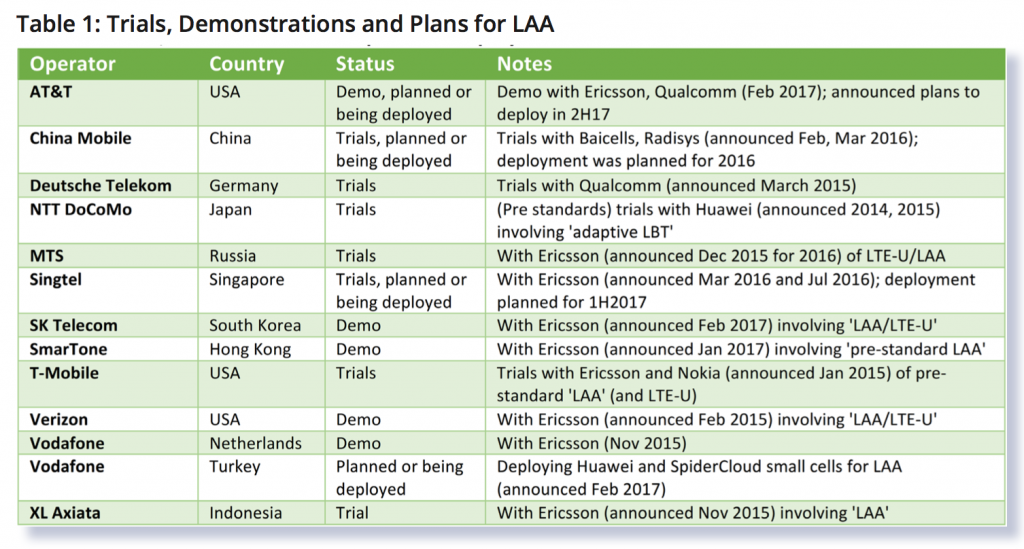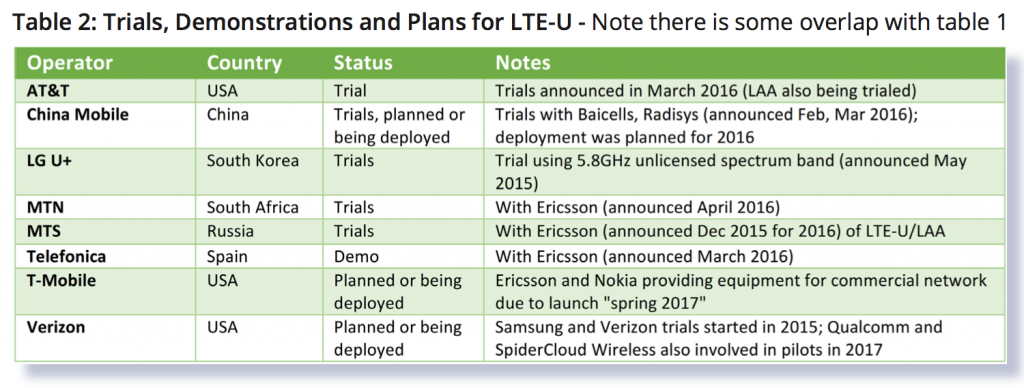The Global Mobile Supplier’s Association (GSA) has started tracking the use of unlicensed spectrum to improve LTE throughput. It recently issued its first in a series of quarterly reports. The report can be downloaded following a registration process.
GSA summarizes various approaches to combining LTE and unlicensed spectrum as follows:
LAA, a 3GPP standard finalized in Release 13 (Rel-13), involves a licensed LTE band as the primary carrier and Carrier Aggregation (CA) used to add a carrier in unlicensed 5 GHz (Wi-Fi) spectrum for the downlink only. In Rel-14, enhanced LAA (eLAA) will add uplink support. High-priority traffic can use the licensed band, while lower priority traffic can use the Wi-Fi channel. The decision on traffic allocation is made by the LAA-enabled base station/small cell, and there is no impact on the core network infrastructure. TDD and FDD modes are supported in the standard. Fair coexistence in the unlicensed channel is provided by a region-specific listen-before-talk (LBT) capability to ensure channels are clear before transmission. LBT is mandatory in the EU and Japan.
LTE-U is a pre-Release 13 technology pioneered in the U.S. (notably by Verizon and T-Mobile) and also being trialed in other countries including South Korea. It is similar to LAA with Carrier Aggregation. There are no core network changes. Decisions on spectrum use are made by the base station/small cell – except that LTE-U uses Carrier-Sensing Adaptive Transmission (CSAT) rather than LBT to determine when the 5 GHz unlicensed WiFi spectrum is in use to maintain fair coexistence. Development of the industry standard has been led by the LTE-U Forum.
LWA (LTE Wireless-LAN Aggregation), a 3GPP Rel-13 standardized technology, aggregates carriers at the packet data convergence protocol (PDCP) layer and uses the Dual Connectivity feature from 3GPP Rel-12. LWA supports downlink aggregation only; enhanced LWA (eLWA — a work item for Rel-14) will add uplink support. Separate nodes (a WLAN access point and an LTE base station) are used, and these can be physically separate or collocated in a single unit. The eNodeB makes the decision on activation of LWA and the use of the bearers. LBT is used to ensure fair coexistence in the unlicensed band. Both 2.4 GHz and 5 GHz unlicensed spectrum bands can be used.
LWIP: (LTE WAN Integration with IPSec tunnel) is a Rel-13 feature similar to LWA but performing aggregation and switching at the IP layer. It’s been designed to require no changes to existing WLAN infrastructure, and in its Rel-13 version can support uplink data transmission as well as downlink.
MulteFire is an approach using unlicensed spectrum for LTE, but with no aggregation with a licensed carrier.
GSA’s report is titled LTE in Unlicensed Spectrum, perhaps for convenience, but there’s more than that going on above. Only the first two, LAA and LTE-U, use LTE in unlicensed spectrum to augment licensed LTE capacity. LWA and LWIP keep LTE on its licensed channel but bind it more tightly with unlicensed Wi-Fi for better performance. MulteFire, as with LAA and LTE, is LTE in unlicensed spectrum but with no tie to licensed operation. GSA notes that these terms, at times, have not been used consistently in press releases and other industry statements, so we use some caution and realize that, at a high level, we’re talking about several modes of increasing 3G and 4G capacity, some similar, some not.
The report includes the status of trials, demonstrations, and plans for LAA, LTE-U, and LWA:
GSA doesn’t guarantee this information is complete but says it makes a reasonable effort to be comprehensive and accurate. It solicits input on these tables, apart from its own data collection process.
LAA has a lot of weight behind it from 3GPP; it can be considered a global standard and seems to dominate.
LTE-U was in part a time-to-market play that took too long for the FCC to approve; it’s now not so timely. LTE-U interest may now migrate toward the broader ecosystem of LAA. Table 2 shows more activity in LTE-U outside the U.S. than I expected.
The Wi-Fi industry would prefer operators select LWA to augment capacity. We’ll see if there is more pickup of that.
The report also rounds up what’s known about chipset, module, and device support for LAA, LTE-U, and LWA.
The next report is due July 2017.


